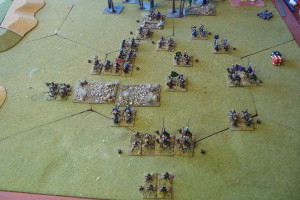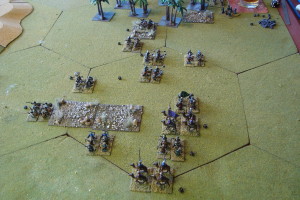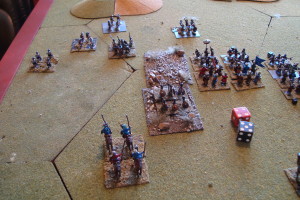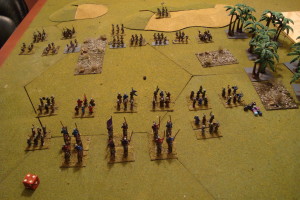Finished up my last game of Irregular Wars for awhile. Another dust up between the Portuguese and Arabs. This was a followup to an initial game, with the addition of chance cards and disease/mishaps.
The card draw effected the Portuguese. They drew a weak leader, which is a -1 DRM to any rally rolls. The disease and mishaps die rolls that take place for each unit right before the start caused a few units on each side to lose one resolve point.
This time the Arabs used their camel units to attack the crossbowmen manning the Portuguese right flank. The crossbow fire was ineffective, and the camels closed with a +2 DRM for charge. So, contrary to the lessons learned in the initial game, camels can be effective.
The big take-away from this game was how an entire wing of your army can collapse after a series of melees. This is a function of the game’s resolve (morale) mechanics.
When a unit’s resolve reaches one (1), it wavers. A wavering unit must withdraw 1D3. The opponent rolls for pursuit. If allowed, it can contact the wavering unit again, receiving a charge bonus, if applicable. If the wavering unit contacts a friendly unit (no interpenetration in these rules), the contacted unit has an immediate loss of one (1) resolve. When a unit’s resolve reaches 0, it scatters. Any unit within two (2) movement units (2u in game terminology), suffers an immediate loss of one (1) resolve. This can be quite a chain reaction, with waverers withdrawing into friendly units or being hacked at by pursuers. Take a look at what happened to the Portuguese right flank.
In the top photo, several Portuguese units have already scattered. In the next photo, the entire wing is gone. However, you’ll notice the Arab center is in very bad shape, also. Quite a game!
As reported earlier, Irregular Wars will come off the bigger table to make way for Red Actions! However, it will be played this Winter, because it’s just too much fun.



